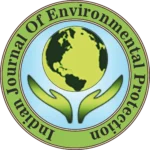IJEP 41(10): 1177-1181 : Vol. 41 Issue. 10 (October 2021)
A. Fitri1*, Y. Sattar2, A. Nani3, M. Ramdiana4 and M. Ismail5
1. Universitas Bosowa, Department of Chemical Engineering, Makassar – 90231, Indonesia
2. Universitas Muslim Indonesia, Department of Mechanical Engineering, Makassar – 90231, Indonesia
3. Universitas Bosowa, Department of Environmental Engineering, Makassar – 90231, Indonesia
4. Universitas Muhammadiyah, Department of Urban and Regional Planning, Pare-Pare – 91131, Indonesia
5. Universitas Fajar, Department of Chemical Engineering, Makassar – 90231, Indonesia
Abstract
The research of the adsorption kinetics of phenol in aqueous solution was studied by measuring the concentrations of remaining phenol in the solution as a function of time (t) and the parameters of the operating temperature (T), the particle diameter of activated carbon (d) and the ratio of the mass of the adsorbent to the mass solution (r). This research used the adsorption method by using local charcoal activated carbon products. The study was conducted by measuring the adsorption velocity (the ratio between the concentration of adsorbent before and after the adsorption operation took place) as a function of time, by varying the operating temperature, grain size, and the ratio of the mass of the adsorbent per mass of solution. In this research, the method used to evaluate constants value in the empirical rate expression is the graphical method. The results of the research show this adsorption method is one way of handling the waste which is quite easy and economical.
Keywords
Industry, Adsorption kinetics, Phenol, Charcoal, Local charcoal, Activated carbon
References
- Schwela, D., et al. 2006. Urban air pollution in Asian cities. Earthscan, UK.
- Rashid M., et al. 2014. PM10black carbon and ionic species concentration of urban atmospheric in Makassar of South Sulawesi Province, Indonesia. Atmos. Poll. Res., 5: 610-615: doi: 10.5094/APR.2014.070.
- WHO. 2002. The world health report 2002: Reducing risks, promoting health life. World Health Organization, Geneva.
- Sattar, Y., et al. 2012. A preliminary survey of air quality in Makassar city South Sulawesi, Indonesia. J. Teknol. (Sci. Eng.). 57:123-136.
- Sattar, Y., et al. 2014. Black carbon and elemental concentration of ambient particulate matter in Makassar, Indonesia. IOP Conf. Series: Earth Env. Sci., 18 (1):2099, doi: 10.1088/1755-1315/18/1/012099.
- Saini, M., et al. 2018. The influence of throat length and vacuum pressure on air pollutant filtration using ejectors. AIP Conference Proceedings. doi: 10.1063/1.5042939.
- Sattar, Y., et al. 2019. Characteristics of the PM10In the urban environment of Makassar, Indonesia. J. Urban Env. Eng., 13(1): 198-201: doi: 10.4090/juee.2009.v13n1.198207.
- Lynam, West., et al. 1995, Adsorption of p-nitrophenol from dilute aqueous solution. J. Chem. Education. 72:80-84.
- Tanasale, M.F., A. Killay and M. Saily. 2006, Chitosan from waste Tiger shrimp (Penaeus monodon) as an adsorbent of phenol, Alchemy J., 5:23-30.
- Gupta, V.K. 2009. Application of low-cost adsorbents for dye removal : a review. J. Env. Manage., 90: 2313-42.
- Li, G.T., et al. 2015. Efficient adsorption behaviour of phosphate on La-modified tourmaline. J. Env. Chem. Eng., 3(1): 515-522.
- Alaerts, G. and S.S. Santika. 1984. Research methods, Water: Usaha Nasional.
- Sophie, B. and K. Muthukumaran. 2010, Chromium (VI) sorption and recovery by chemically activated high temperature syzygium jam-bolanum nut carbon by column studies. Indian J. Env. Prot., 7(1): 299-307.
- Tong, X.J. and R.K. Xu. 2013. Removal of Cu(II) from acidic electroplating effluent by biochars generated from crop straws. J. Env. Sci., 25: 652-658.
- Ding, Z.H., et al. 2016. Removal of lead, copper, cadmium, zinc and nickel from aqueous solutions by alkali-modified biochar: Batch and column tests. J. Ind. Eng. Chem., 33: 239-245.
- Park, S.H., et al. 2016. Removal of copper(II) in aqueous solution using pyrolytic biochars derived from red macroalga Porphyra teners. J. Ind. Eng. Chem., 36: 314-319.
- Qiu, M.Q., et al. 2018. XANES and EXAFS investigation of uranium incorporation on nZVI in the presence of phosphate. Chemosphere, 201: 764-771.
- Hu, B.W., et al. 2019. Decontamination of Sr(II) on magnetic polyaniline/graphene oxide composites: Evidence from experimental, spectroscopic and modeling investigation, ACS Sustain. Chem. Eng., 5:6924-6931.
- Hanafiah, M.A.K.M., et al. 2012. Acid blue 25 adsorption on base treated Shorea dasyphylla sawdust: Kinetic, isotherm, thermodynamic and spectroscopic analysis. J. Env. Sci., 24: 261-268.
- Chen, C., et al. 2017. Removal of methylene blue by seed-watermelon pulp-based low-cost adsorbent: Study of adsorption isotherms and kinetic models. J. Disper. Sci. Tech., 38: 1142-1146.
- Khalid, K. and M.A.K.M. Hanafiah. 2014. Kinetic and isotherm adsorption studies of methylene blue on sulphuric acid treated spent grated coconut (Cocos nucifera). Adv. Mater. Res., 970: 192-197.
- Hanafiah, M.A.K.M., et al. 2018. Methylene blue adsorption on aloe vera rind powder: Kinetics, isotherm and mechanisms. J. Nature Env. Poll. Tech., 17: 1055-1064.
- Chengcai, H., et al. 2019. Adsorption kinetics and isotherms of Cr(VI) ions in aqueous solution by biochar derived from Torreya grandis nutshell. J. Nature Env. Poll. Tech., 18: 1375-1380
- Mulyono, P. and Wibisono. 2007. Kinetic the adsorption of ammonia in water with activated carbon, Forum eng., 31(3): 255-263.
- Qin, L., et al. 2009. Nitrogen, phosphorus and potassium adsorption characteristics of peat, sandy soil, loamy soil and their mixture. J. Central South University Forestry Tech., 29(1): 20-24.
- Qi, N., et al. 2016. Effects of peat and mushroom residues on removing ammonia-nitrogen and total phosphorus in wastewater. J. Nature Env. Poll. Tech., 15: 1373-1380.
